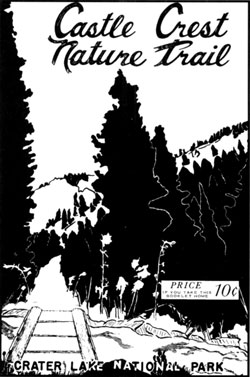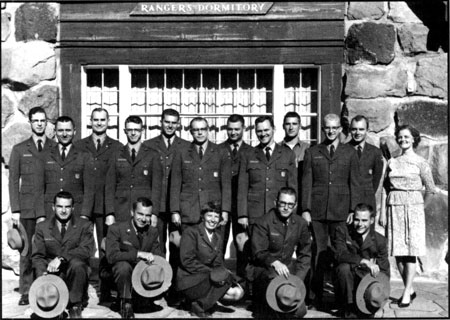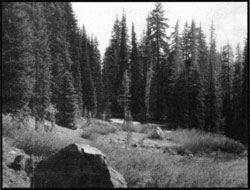Castle Crest After Dark
For several years after the 1956 edition of Nature Notes finally went to press in 1961, the Crater Lake Natural History Association hoped to produce issues on an occasional basis. This serial did not appear again until its revival in 1992, but a number of potential articles remained in park files. What the author describes is timeless, even though his last season on the naturalist staff was the summer of 1962—Editor.
 The trail guide printed in 1962. |
Located one-fourth mile east of Park Headquarters on the Rim Drive is one of Crater Lake National Park’s most beautiful visitor attractions. Castle Crest Wildflower Garden provides an array of color and picturesque landscape seldom equaled. A gently tumbling mountain stream and numerous springs provide not only moisture necessary for the wildflowers, but also add a touch of beauty themselves. This is Castle Crest during the day; but what happens after dark?
Instead of the chromatic schemes of the day, a moonlit night reveals a terrain of black silhouettes against a dark blue sky. If you were to enter Castle Crest on such an evening during the month of July, your greeting could be the vibrations produced by the friction of an insect’s legs—the chirping of a cricket. The bubbling of an invisible mountain stream in the background seems louder than during the day.
Far to the west, the hooting of a horned owl can be heard, and just above this distant sound, the celestial giant Arcturus twinkles its reddish light.1Ahead on the trail, the colunmar shape of subalpine firs stand like temple spires against a lighter background where Cygnus continues its flight down Munson Valley on the trail of the Milky Way.2 As we cross the little log bridge by sign post number 10, the mountain hemlock trees on the distant northeastern hill identify themselves with their drooping tops—weary, so it seems, from the duties of the day.3 Just above this hill, the “W” of Cassiopeia seems to stand for water, which appears to have its source in that direction.4

Naturalist staff in 1962. Author is in the middle row, third from left. NPS photo.
 Castle Crest Wildflower Garden in the daylight, 1963. NPS photo by Denis Baskin. |
Farther along the trail, we carefully step through the darkness from one flat rock to the next. It might become easy to be aware that nature’s feathered acrobat during the day has been replaced by an equally specialized member of the mammal group. Twisting and darting through the night air, using its natural radar to find the way, a brown bat seems to assume the role played by the rufous hummingbird in the sunlit hours.
As we peer toward the southeast sky, Jupiter’s glow appears second only to the full July moon. Outlined below these two brilliant spectacles, the Scorpion seems to suggest the direction in which an animal could be found.5 Within this beautiful constellation our eyes catch Antares’ light which has aged some 400 years before it reaches us.6
Upon completing our circle of Castle Crest Wildflower Garden, a snapping twig tells us that ours are not the only eyes enjoying this beautiful scene. Casting a flashlight in the direction of the disturbance, we see the eyes of a black-tailed deer shining like two jewels in the dark forest. The background noise of crickets, a mountain stream, and the horned owl have gained a new member in the occasional grunt of a Cascade frog as we return to our starting point on the trail loop. This is Castle Crest after dark, an example of nature’s ever-changing panorama that does not always require the light of day to reveal its beauty.
Notes:
1The most brilliant star in the evening skies of late spring and summer. It can be found by following the curved handle of the Big Dipper (Ursa Major) onward along an arc of approximately 30 degrees.
2A constellation containing a group of stars known as the Northern Cross.
3The stops have since been renumbered.
4Cassiopeia is a constellation lying on the opposite side of the North Star from the handle of the Big Dipper.
5Scorpius or scorpio is seen near to the horizon in the continental United States.
6This star is often called “Heart of the Scorpion” due to its brightness.
John E. Butler served as a seasonal naturalist at Crater Lake National Park during the 1961 and 1962 seasons.

